Understanding Our Environment

August 2020 Issue
Understanding Our Environment is the internal newsletter for the Kansas Biological Survey & Center for Ecological Research community. Please email biosurvey@ku.edu regarding any errors or omissions.
Photo: Emma Hauser, doctoral student in the Billings Lab, studies carbon cycling by plants growing in soils with varying nutrient profiles at the KU Field Station greenhouse complex. The work is funded by a KU Dept. of Ecology and Evolutionary Biology Graduate Research Fellowship and a National Science Foundation grant. (Andy White/KU Marketing)
Grants
Kansas Biological Survey researchers have been awarded a grant of $571,375 by the National Science Foundation’s FSML Program (Improvements in Facilities, Communications, and Equipment at Biological Field Stations and Marine Laboratories) for a new research support facility at the KU Field Station. The new facility will include construction of a new building, renovation of the existing aquatic lab, and other features to integrate these structures with the rest of the facilities complex around the Armitage Education Center.
The new building will provide a new workshop and staff workroom to better support management activities of the Field Station staff, as well as a research commons for field researchers and students, plus a clean room for sensitive equipment and a dedicated soil sterilization and soil processing facility. The renovation will provide a large research commons to accommodate seasonal overflow activity, including sample processing, staging for field research and other activities. Bryan Foster, KU Field Station director, is principal investigator. Co-PIs are Jim Bever, Amy Burgin, Ben Sikes and Ted Harris. Bryan a professor of ecology and evolutionary biology (EEB) and a Kansas Biological Survey senior scientist; Jim is Foundation Distinguished Professor of EEB and a Bio Survey senior scientist; Amy and Ben are associate professors of EEB and Bio Survey associate scientists; Ted is a Bio Survey assistant research professor.
Sharon Billings, along with collaborators from four other universities, has been awarded a five-year National Science Foundation grant of $4.2 million for a project titled “Collaborative research: Network Cluster: Geomicrobiology and Biogeochemistry in the Critical Zone.” Emma Aronson of the University of California-Riverside is principal investigator; other collaborators are from the University of California-Merced, UC-Berkeley and the University of Arizona. Sharon is Dean’s Professor of EEB and a Bio Survey senior scientist.
Ted Harris, Bio Survey assistant research professor, and Debbie Baker, Bio Survey researcher, will work with a diverse group of stakeholders on a short-term pilot project this summer and fall:“Monitoring Clinton Lake, Kansas, with high-frequency water quality data loggers.” The project is funded by the City of Lawrence and has two goals: 1) create an authentic learning experience for high school students; and 2) help the City of Lawrence answer real-world questions related to water quality degradation in Clinton Lake. Project partners include the City of Lawrence, the Kansas City District of the U.S. Army Corps of Engineers, the Kansas Alliance for Wetlands and Streams, Kansas Mesonet and Lawrence Free State High School. NSF EPSCoR MAPS Outreach funding helped purchase temperature loggers for the project. Ted is PI, and Debbie is Co-PI. Below, Debbie prepares a research buoy. Water temperature measurements will be collected every 10 minutes at 10 different depths.
Publications
A new database, “SoDaH: the Soils Data Harmonization database, an open-source synthesis of soil data from research networks, version 1.0” (PDF attached), has been published on the EDI Data Portal. It was created by a large group of researchers, including Sharon Billings, Dean’s Professor of EEB and a Bio Survey senior scientist, and Sara Baer, Bio Survey director and senior scientist and professor of EEB.
Sharon also has published the paper “Short- and long-term temperature responses of soil denitrifier net N2O efflux rates, inter-profile N2O dynamics, and microbial genetic potentials” in the journal Soil. The paper is on the nitrogen dynamics that result in the powerful greenhouse gas nitrous oxide being released to that atmosphere at a faster rate with warming from boreal forests. The lead author is Kate Buckeridge, former postdoctoral researcher in the Billings Lab. KJ Min, a former doctoral student in the Billings Lab, is a co-author.
In addition, an essay, by Sharon along with Ligia Souza, a Ph.D. candidate in the Billings Lab, was published in News & Views at Nature Geoscience describing the importance of a recent paper in that journal. The full issue of the journal has now been published, with a set of focus articles on the subject of soil organic carbon and featuring Sharon and Ligia’s essay.
Jude Kastens is co-author of a paper, “Temporal coherence between lake and landscape primary productivity,” published in the journal Ecosystems. The lead author is Jonathan Walter, a former postdoctoral researcher here in the Reuman Lab, now at the University of Virginia. Jude, a Bio Survey associate research professor, shares that in addition to helping with manuscript, his involvement entailed development and provision of a 30-year geospatial plant phenology dataset developed from satellite NDVI, which provided a proxy for annual landscape primary productivity that was used in the research.
Christopher Rogers has authored a new paper, “Rediscovery of the horseshoe shrimp Lightiella serendipita Jones, 1961 (Cephalocarida: Hutchinsoniellidae) in San Francisco Bay, California, USA, with a key to the worldwide species of Cephalocarida,” published in the Journal of Crustacean Biology (PDF attached). The paper reports the first records of a rare crustacean in the class Cephalocarida in the 30 years since its discovery. The U.S. Geological Survey marine section found specimens and asked Christopher to identify them. In the paper, Christopher’s co-authors describe the crustaceans’ specific niche, their habitat and ecological associations, and Christopher provides the first identification key to the cephalocarids of the world. Christopher is a Bio Survey assistant research professor.
Christopher also has published nine new papers in the proceedings of the mid-year meeting, in Hong Kong, of The Crustacean Society. He co-chaired a special session, with paleontologist Thomas Hegna, on the extinct and extant clam shrimp, the first-ever such symposium. Christopher said the paleontologists and biologists previously had been working in their own spheres, having little to do with the impacts of the others group’s work on their own.
In addition, Jim Thorp and Christopher Rogers have published a new chapter for their book, Keys to Neotropical and Antarctic Fauna. The full citation is: Damborenea, C., D.C. Ropers, and J.H. Thorp (eds.). 2020. Keys to Neotropical and Antarctic Fauna. 1017p. ISBN: 978-0-12-804225-0. Jim is a professor of EEB and a Bio Survey senior scientist.
Kelly Kindscher’s new book, Sahnish (Arikara) Ethnobotany, has been published by the Society for Ethnobiology. Co-authors are Loren Yellow Bird, Michael Yellow Bird, and Logan Sutton. The book describes the traditional use of wild plants by the tribe for food, medicine, craft and other uses. It is the first published compilation of traditional plant uses of this Northern Great Plains tribe. The Society for Ethnobiology also provided a grant that allowed for copies of the book to be provided to Arikara youth on the reservation of the MHA Nation (Mandan, Hidatsa, Arikara) at Fort Berthold, North Dakota. Kelly is a professor in the Environmental Studies Program and a Bio Survey senior scientist. Michael Yellow Bird is director the KU’s Indigenous Studies Program.
Field Photos
In late June, KU photographers gathered both still and video images at two long-term research sites at the KU Field Station, as well as footage of projects at the greenhouse complex and the Native Medicinal Plant Garden. Below are a few of the first photos they’ve shared with us, showing a citizen science project involving rosinweed at the medicinal garden (with Jennifer Moody, researcher in the Kindscher Lab at the Bio Survey; The Land Institute is a partner); at Bryan Foster’s long-term prairie restoration experiment (with Patti Beedles, Bio Survey assistant researcher); and more of Emma Hauser’s greenhouse work. Bryan is Field Station director, professor of ecology and evolutionary biology (EEB) and a Bio Survey senior scientist.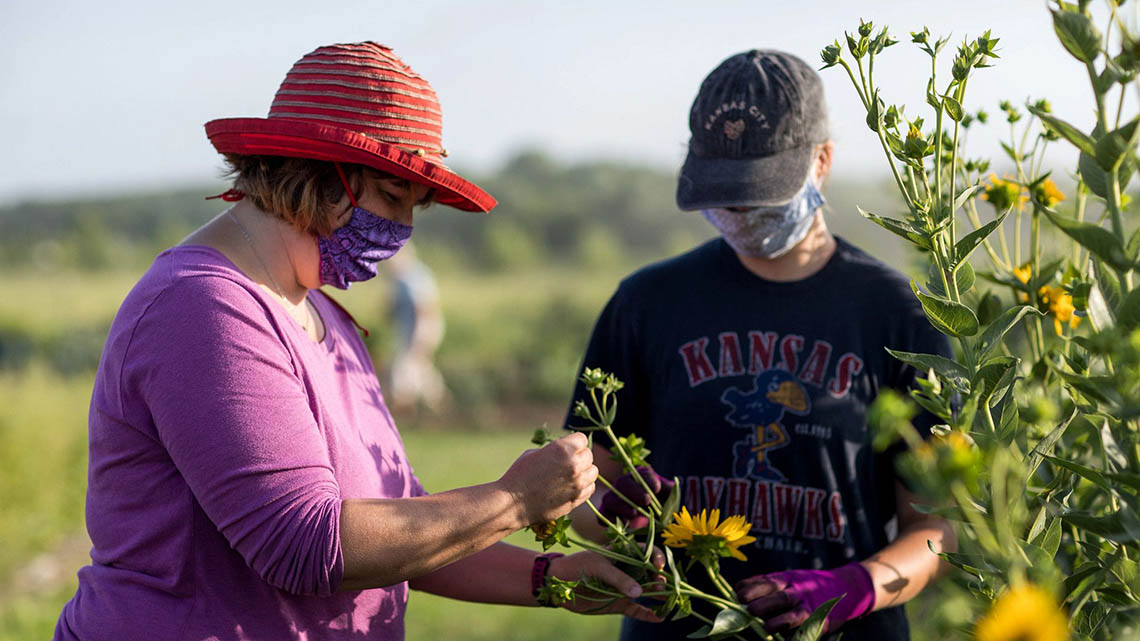
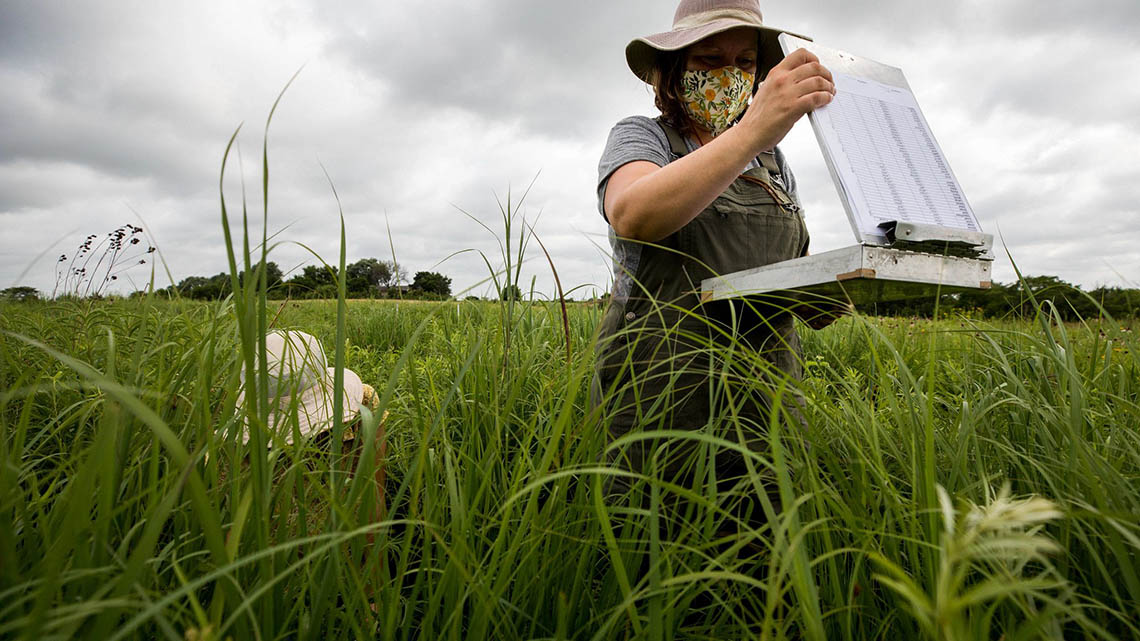
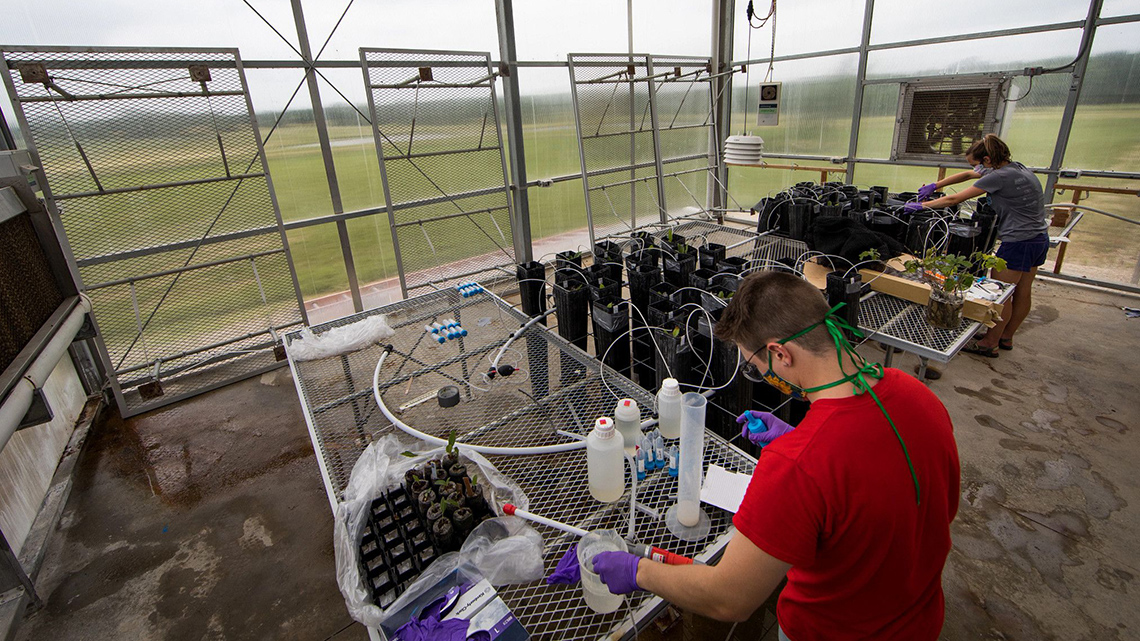
Publicity
Ongoing research by Ted Harris on harmful algal blooms (HABs) was covered in the U.S. Environmental Protection Agency’s EPA Region 7 Feature this month, Keeping Tabs on HABs: Research Reduces Risk. The writer was Alyssa Cole, KU graduate student in history, who worked for the EPA over the summer.
Jude Kastens worked with long-time commercial partner Planalytics in tracking damage from the little-publicized August 10 derecho storm event that devastated communities and crops across 7 million acres in Iowa, Nebraska and South Dakota. Wind speeds varied from 60 to 130 mph. Jude created a map illustrating wind speeds across the area, and the project was covered in the August 21 Planalytics Agribusiness Spotlight, which is attached to this email. Jude is a Bio Survey associate research professor.
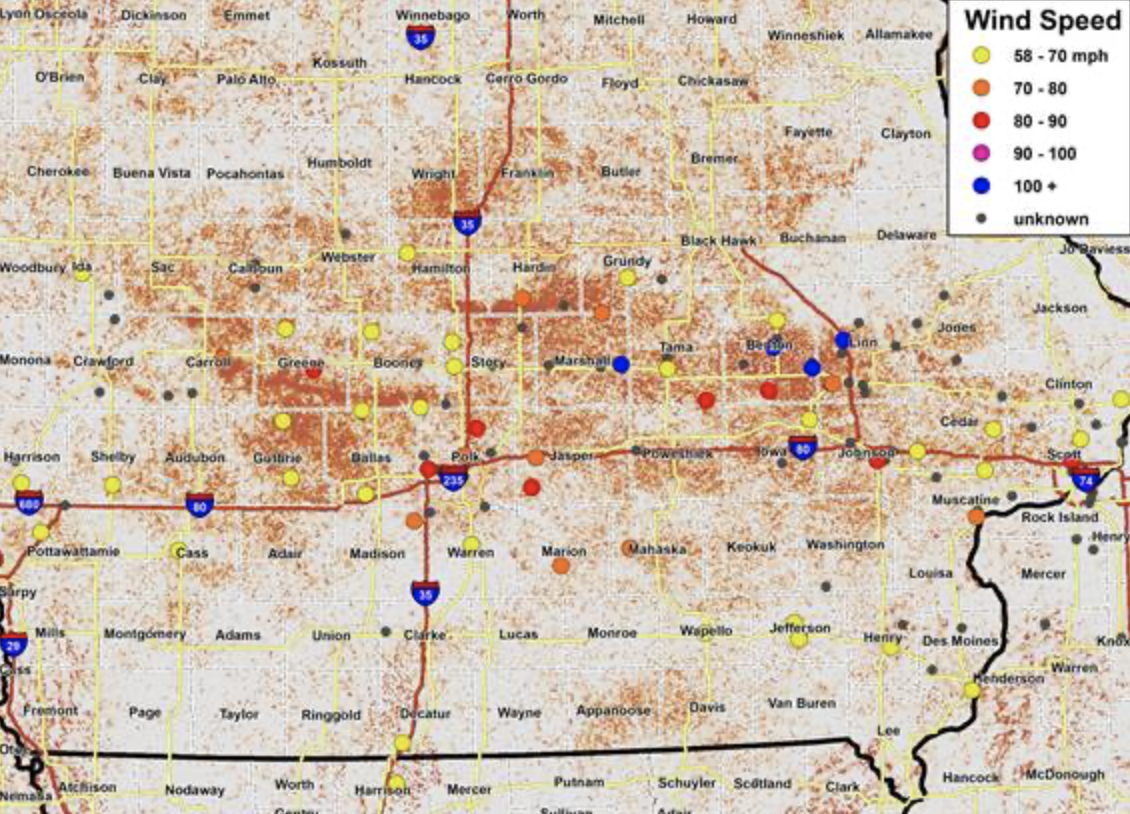
KU News published a story on July 16 about the research behind the three-year $720,000 NSF grant to Maggie Wagner and colleagues at the University of Nottingham. Their project is titled, “A holistic approach to understand drought adaptation in plants, their symbionts, and free-living microbiomes.” Maggie is an assistant professor of EEB and a Bio Survey assistant scientist.
Online
Angie Babbit, outreach coordinator for Monarch Watch, shares that Alixandra Prybyla, a recent Columbia University graduate and a graduate student at the University of Edinburgh, noticed that there were monarchs flying in the gardens of the popular Nintendo Game “Animal Crossing: New Horizons” and asked Monarch Watch if she could create custom monarch-themed outfits for those who play the game. Monarch Watch staff agreed and helped her edit text for this free publicity. Previously, Alixandra worked as a graphic designer and fundraiser for a New York entomological group. She wrote to Monarch Watch staff: “My specialization is the integration of citizen science in conservation ecology—your work has been a HUGE inspiration to me.” The images will be on social media soon. This YouTube video shows where some of the butterflies appear (at about the 40-second mark); the human character goes into an insect lab at about the 1:30 mark.
Behind the Scenes
Helen Alexander and Ben Sikes will co-organize and resume the Friday Ecology Seminars for the fall 2020 semester. Helen will continue to organize and schedule seminars, and send email notifications, and Ben will manage the technical aspect of the presentations via Zoom. Helen is a professor of EEB, a member of the KU Field Station Executive Committee and a Bio Survey affiliate. Ben an associate professor of EEB and a Bio Survey associate scientist.
Ben Sikes and Sherry Kay have been surveying and cataloging macrofungi in the Rice Woods tract of the KU Field Station’s Baldwin Wood Forest Preserve. Sherry is lead author of the updated forthcoming version of the book, A Guide to the Mushrooms of Kansas, which will be published by University Press of Kansas. Ben will be a co-author. A prescribed burn is being planned for this fall by Field Station staff and the Kansas Forest Service for the Rice Woods (the first since it was deeded to KU Endowment by The Nature Conservancy in the 1970s). Ben and Sherry hope to learn how prescribed fire alters the fruiting of fungi there. Ben has uploaded many photos of mushrooms and plants in Rice onto his iNaturalist observations page (below is Oak-loving Gymnopus, Gymnopus dryophilus), and these are being added to the Fungi of Kansas list within iNaturalist. Previously, there were almost no records from Rice on iNaturalist.
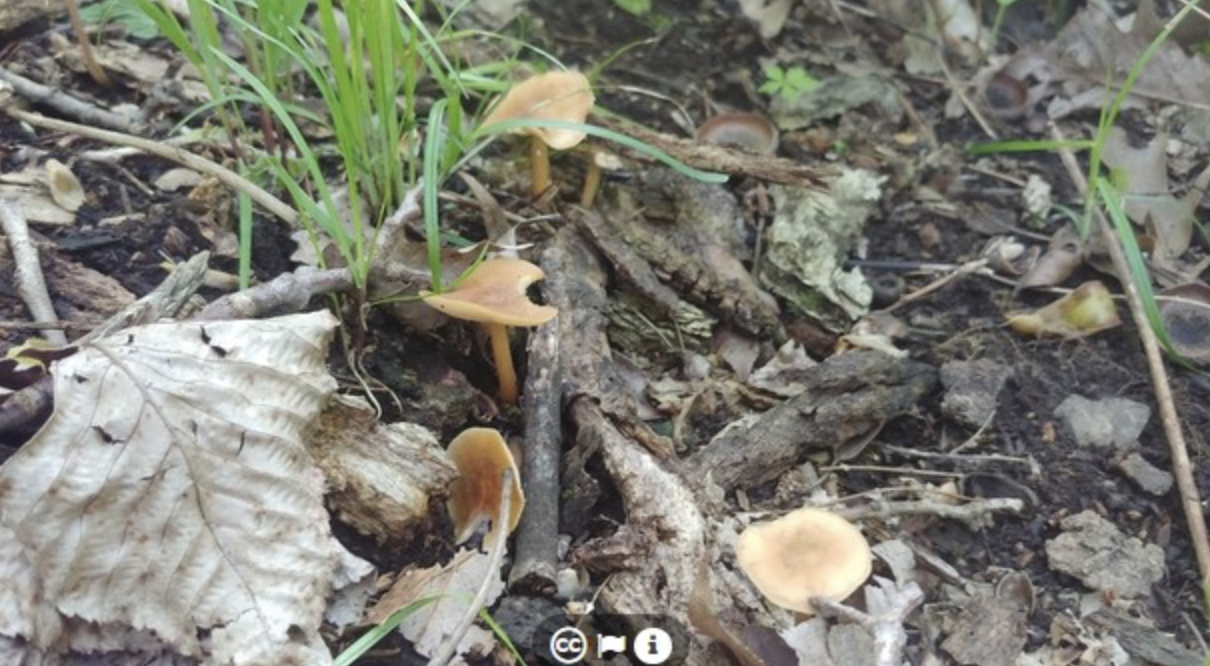
Helen Alexander set up markers for a self-guided plant walk along the KU Field Station’s Rockefeller Prairie Trail this morning. We took some video and still footage and will add a page to the Bio Survey website soon with a video, a map and an information sheet for use by people visiting the trail. Helen is a professor of EEB and a member of the Field Station Executive Committee and, in her words, “just someone who enjoys plants and who enjoys sharing them with others.”
Beyond KU
Helen Alexander invites you to join Grassland Heritage Foundation volunteers who will clear invasive species from the native prairie at the BlackJack Battlefield site just outside Baldwin City and collect native seed to restore the prairie’s diversity. Seed collection dates are Aug. 22 and Oct. 17. Invasive species removal dates are Sept. 17, Oct. 10 and Oct. 24. RSVP using this form. Workdays will adhere to all suggested COVID-19 prevention guidelines, including social distancing recommendations. Helen, as well as Kathy Denning, former doctoral student in the Foster Lab, are on the Grassland Heritage Foundation board of directors. One of the primary organizers for these events is Courtney Masterson, former graduate student in Helen’s lab and researcher at the Bio Survey.